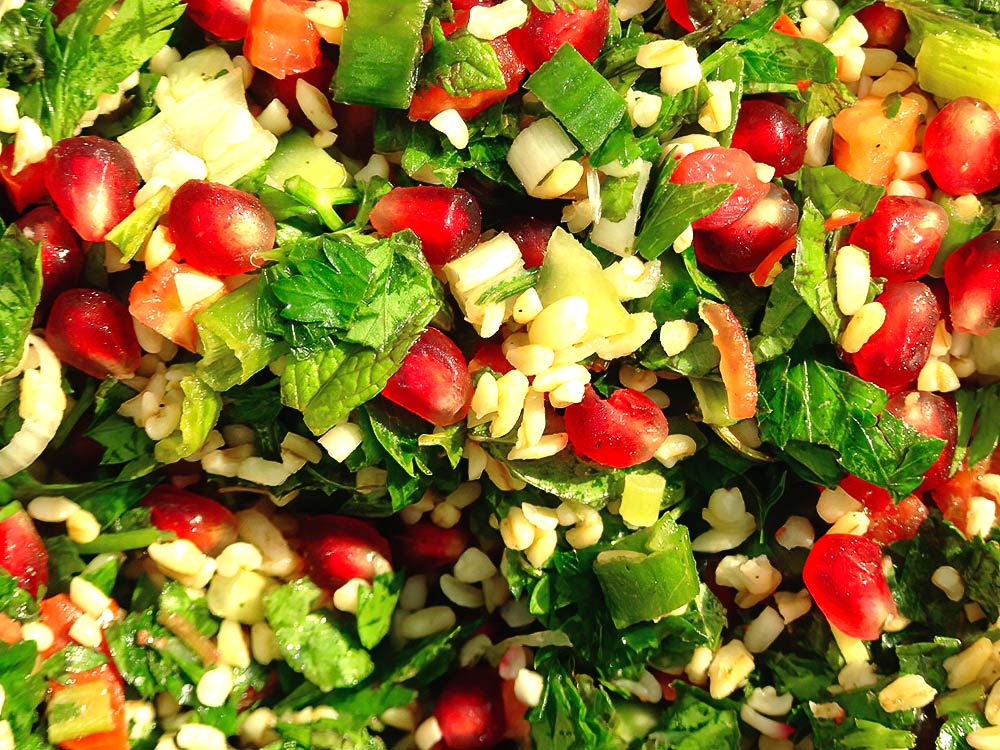Tabbouleh is a traditional Middle Eastern salad that combines fresh parsley, mint, tomatoes, bulgur wheat, and a tangy lemon dressing. This version also includes pomegranate seeds for a burst of sweetness, adding color and flavor. It is a light, healthy, and flavorful dish that works well as a side or a main course for a refreshing, nutritious meal.
Preparation Time
- Prep Time: 20 minutes
- Cook Time: 10 minutes (for bulgur)
- Total Time: 30 minutes
Ingredients (For Four People)
- 1/2 cup bulgur wheat
- 1 cup hot water
- 1 bunch fresh parsley, finely chopped
- 1/2 bunch fresh mint, finely chopped
- 2 medium tomatoes, diced
- 1 cucumber, diced
- 3 green onions, finely chopped
- 1/2 cup pomegranate seeds
- 1/4 cup lemon juice (juice of 1 lemon)
- 1/4 cup olive oil
- Salt and pepper, to taste
1 tablespoon is circa 15 ml, and a teaspoon is circa 5 ml.
Preparation Method
Step 1: Prepare the bulgur
Place the bulgur in a bowl and pour the hot water over it. Let it soak for about 10 minutes or until the bulgur is tender and has absorbed the water. Fluff with a fork and let it cool.
Step 2: Chop the vegetables and herbs
While the bulgur is soaking, finely chop the parsley, mint, tomatoes, cucumber, and green onions. The herbs should be minced finely for a smooth texture.
Step 3: Mix the salad
Combine the soaked bulgur, chopped herbs, tomatoes, cucumber, green onions, and pomegranate seeds in a large bowl.
Step 4: Make the dressing
In a small bowl, whisk together the lemon juice, olive oil, salt, and pepper until well combined.
Step 5: Toss and serve
Pour the dressing over the salad and toss gently until all the ingredients are well coated. Taste and adjust the seasoning with salt, pepper, or lemon juice. Serve chilled or at room temperature.

Tips and Tricks
For a more authentic flavor, soak the bulgur in cold water for 30 minutes instead of hot water. The pomegranate seeds are optional but add an excellent sweet contrast to the tangy dressing. For a gluten-free version, substitute quinoa for the bulgur.
Serving Suggestions
Tabbouleh is typically served as a side dish to grilled meats, falafel, or other Mediterranean dishes. It also works as a light main course with pita bread or hummus. For added texture, top with toasted pine nuts.
Wine Pairing
A crisp white wine like Sauvignon Blanc or a light rosé complements the freshness of the herbs and the tartness of the lemon. For a non-alcoholic option, serve with a refreshing glass of iced mint tea or lemonade.
Nutritional Information (Per Serving)
- Calories: 180
- Protein: 4g
- Fat: 10g
- Carbohydrates: 20g
Dietary Modifications
- Gluten-Free: Substitute quinoa for bulgur to make the dish gluten-free.
- Dairy-Free: This recipe is naturally dairy-free.
- Vegan: The recipe is vegan as is.
Storage Suggestions
Refrigeration: Store leftover tabbouleh in an airtight container in the refrigerator for up to 3 days. The flavors will continue to meld, but the salad is best enjoyed fresh. To maintain its vibrant flavor, you may want to refresh the salad with a squeeze of lemon juice before serving.
Freezing: Tabbouleh is not ideal for freezing, as the fresh herbs and vegetables will lose their texture and flavor upon thawing. You should make this salad fresh and refrigerate leftovers for short-term storage.
About the Tabbouleh Salad
Tabbouleh is one of the most iconic dishes of Levantine cuisine, known for its fresh ingredients and bright flavors. The salad’s base of finely chopped parsley and mint, combined with tomatoes and cucumber, brings a refreshing quality to any meal. Adding bulgur wheat provides a subtle nutty texture and makes the dish more substantial, turning it from a simple side salad into a satisfying one. The tangy lemon dressing ties everything together, offering a zesty contrast to the earthy bulgur and the sweetness of the vegetables and pomegranate. Its light yet flavorful profile makes tabbouleh a popular choice for health-conscious individuals, offering a nutrient-dense dish packed with fiber and vitamins. The dish’s versatility allows it to be easily adapted to different tastes and dietary preferences, with substitutions like quinoa for gluten-free versions or additional vegetables for a more colorful presentation.
Cultural Context
Tabbouleh originated in the Levant, particularly in Lebanon and Syria, where it has long been a staple of traditional mezze platters. The dish’s history dates back centuries, with early versions focusing heavily on the abundant use of fresh herbs rather than the bulgur itself. Parsley, a symbol of health and vitality, plays a central role in many Levantine dishes, and tabbouleh is perhaps its most celebrated form. Over time, tabbouleh has traveled beyond the Middle East, becoming a beloved dish in many parts of the world, from Europe to North America.
In its native context, tabbouleh is typically served alongside other small plates like hummus, baba ganoush, and falafel, emphasizing the Levantine tradition of sharing and communal dining. The focus on fresh, seasonal ingredients reflects the agricultural richness of the region, where herbs, tomatoes, and cucumbers are often abundant. While modern versions of the dish sometimes increase the amount of bulgur, traditional Lebanese tabbouleh maintains a much heavier emphasis on parsley and mint, giving the salad its signature green color. Adding pomegranate seeds in this version adds a modern twist while staying true to the dish’s roots by incorporating ingredients commonly found in Middle Eastern markets.


